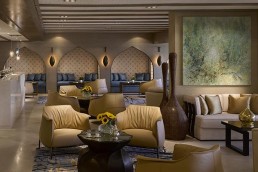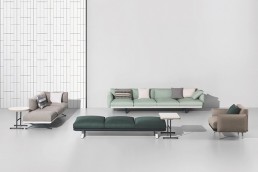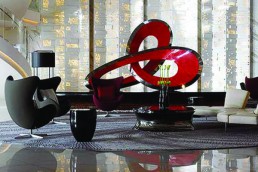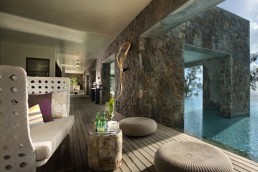HBA designs Kempinski Beirut
Hirsch Bedner Associates has designed the Kempinski Beirut, a new luxury 153-key hotel at the heart of the historic Lebanese capital. The waterfront resort features warmly decorated interiors, a dining area bathed in natural light, event spaces and a collection of locally produced art rooted in the country’s heritage.
At the hotel’s entrance, beige flooring has been cut to include a Rub el Hizb pattern derived from a traditional Muslim symbol. From the top of the 33-foot high ceiling flows a water wall, capturing the essence of ancient ruins and symbolising the mountains and the water that flow through them. To the right of the lobby, the walls are fully clad with grey wood to celebrate the majestic cedar tree forest. Wood planks of various widths capture the texture and natural form of the celebratory tree in Lebanese history, and intricate arabesque motifs are carefully etched into several wood planks adorning the walls.
The hotel also features an original contemporary art collection sourced from Lebanese artists living in the country and abroad, creating an emotional link between the interiors, the location, and the culture. A 23-foot-tall chandelier constructed from clear and amber-toned glass spheres reminiscent of the Lebanese Diaspora hangs in the lobby, its transient light patterns reflecting the movement of people in and out of Lebanon over the years. Elsewhere, the interior façade features dozens of figures perched on the guardrails supporting this same concept. The soft edges on which they sit feature a profile inspired by the architectural detailing of the Byblos ruins, and, as a final touch, area rugs in arabesque patterns and bright tones reflect the sun and sea, bringing the warm Mediterranean outdoors inside.
Elsewhere, the lobby lounge celebrates the warmth and comfort of a traditional Lebanese home. The interior space embraces sunshine and light, with both subtle and vivid colours, harnessing the simplicity of form with the elegance of proportion. Low beamed ceilings with insets of woven textures are reminiscent of the country’s architecture and fishing culture. Carved screens between seating areas create semi-private retreats and pay homage to traditional practice and grand arches are raised above individual seating arrangements, creating a secondary layer within the space.
The lobby bar is wrapped in an intricate Mashrabiya-inspired screen, modernising a traditional Arabic architectural element. Surrounding the bar is a casual area with small seating arrangements accented by scattered rugs in warm teals and browns, also reminiscent of the cedar tree and Lebanese sky. A staircase that leads guests below to the bar and all day dining space is adorned with a handrail inspired by the branch of the cedar tree, and each landing represents a body of water with an infinity edge detail to create the sense of walking through the water between spaces.
Rich colours of burgundy and teal throughout the bar channel the country’s vineyards and winemaking culture, while reflective finishes push the boundaries of volume within the intimate space. The ceiling features insets of oval mirrors creating a sense of lightness and continuity and walls are sculpted with two types of carved screens backed by light and mirror to support this effect. Meanwhile, metal and wood screens with arabesque patterns create further layers within the bar.
Inspired by mint – a key ingredient in Lebanese cuisine – the interiors embrace the freshness and lightness of the herb, engaging the colours of green and teal amidst a beige background. The ceiling is wood-planked in white and grey while upholstered wall panels are punctuated with carved white architectural screens in decorative patterns. A variety of buffet counters, including a Saj, are arranged within the space to display an array of local traditional dishes and the room is bathed in an abundance of natural light from the terrace.
The ballroom is designed as an elegant white box adorned with complex patterns engraved into the walls and ceiling – an homage to the detailing in local architecture. Hues of white and warm colours are juxtaposed by cool grey tones, giving it a neutral backdrop for various event types. The carpet is heavily patterned in grey biomorphic designs and is complimented by elegant draping chandeliers in similar shapes overhead, made of crystal and laser cut metal. Reflective of the cedar tree forest, the wood clad walls in the function rooms feature various widths of light and medium grey planks, and the doors are engraved with cedar leaf patterns, and the carpet designs are a reinterpretation of the needles and blossoms of the cedar trees in tones of grey and green.
Guestrooms and suites are decorated with a combination of strong lines and geometric patterns, with architectural lighting highlighting the feature wall above the headboard – a direct reinterpretation of the cedar tree flower. Furniture handles are derived from the seed of the cedar tree, and are a continuous element throughout. The bathroom has a combined shower and tub in carved beige stone, and light slots are adorned with a glass Mashrabiya pattern recalling the screen design on the bed.
HBA Designer and Partner David T’Kint comments: “We took inspiration from natural elements such as the cedar tree forest, the endless sunshine and blues of the Mediterranean Sea, as well as places of cultural significance, like Mount Lebanon and the Byblos ruins, when we began the project. Various aspects of the Lebanese culture are reinterpreted through the design to create a continuous thread throughout the property.”
Related Posts
19 May 2017
Dordoni designs Boma for Kettal
3 February 2010




